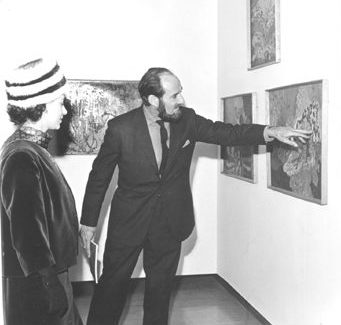New Art From Rhodesia
From the Catalog of: The National Gallery of Rhodesia. Inaugurated by Her Majesty Queen Elizabeth July of 1957

Frank McEwen showing Queen Elizabeth the opening for The Rhodes National Gallery in Salisbury, Rhodesia, 1956
“Triumph of First Congress on African Culture” London Times, 1962
“The Dark Gift” Time Magazine, Sept. 28, 1962
A trip to Africa: Frank McEwen, Rhodesia and Shona Art, 1968 by Adele Aldridge
The inaugural show comprised several elements: European Old Masters from the Louvre, the London National Gallery, the Tate, the Stedelijke Museum, the Rijksmuseum and others; there were also Modern Masters, some Traditional African Sculpture and a small section showing the influence of Africa on twentieth century western Schools; Picasso and the Expressionists.
Later the Gallery was to stage the First International Congress of African Culture: a congress, art exhibitions, dance and music. From the inception it was sought to satisfy the country’s new, and pressing need for culture. In eight years 70 exhibitions were staged. To this panorama all continents contributed.
From the beginning it was obvious also that, in a country where there was no art, neither traditional nor contemporary, a school must be made to arouse latent talents and to form a new, nontraditional culture.
Almost immediately local artists began working with strong encouragement, recognition and promotion from the National Gallery. Our efforts received superb response. Our international exhibitions helped decant ideas which flowed in numerous directions and no wise, as so often is the case, tending to follow one pattern or master.
European artists evolved briskly towards contemporary emancipation, while Africans, beginning with a brand of adult child-art, soon developed masterly and involved sophistication. They instinctively espoused all-African symbols and stylization’s. Here is an intriguing phenomenon at which we do not cease to wonder but for which there are no obvious explanations.
Sculptural features common to West Africa- the enlarged head, seat of the spirit; the sturdy sculptural legs; the chevron, the snake and the spiral symbols all came into carving, while painting appeared distinctly , expressionistic. Africans newly discovering paint tended towards a type of German Expressionism, likewise and inversely, Germans newly discovering African art in 1905 produced in paint, Expressionism.
Whereas most European artists went essentially towards paint, Africans indulged in both paint and carving. Strangely, in our School, wood carving, so dear to ancient Africa, never thrived. Wood is the medium of the mechanized ‘airport’ tourist-art manufacturers, and our artists seemed to scorn it. Soapstone became a cherished medium.
Therein may be some distinct link with tradition because the great birds and other objects found at Zimbabwe were of the same material. Our most courageous carvers, however, even reject soapstone and work the toughest granite, not refusing the archaic technique of grinding one stone against another over a long period of time-producing only one work a month, or less.
The School in the last years has achieved a universal appeal. A beaten track is being worn to our door. It comes from far afield; the Americas, Europe, the East and, of course , Africa herself.
On one hand we can say that Rhodesia is becoming widely known today as the place where art comes from, and this is only a very beginning.